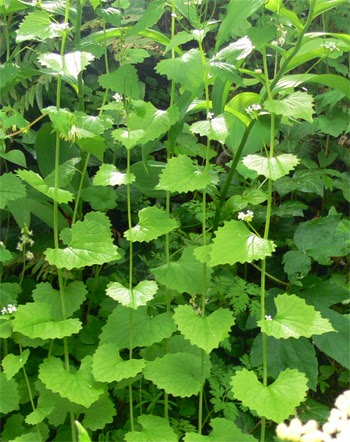Garlic Mustard
Garlic mustard, Alliaria petiolata, is a non-native plant in Minnesota, brought to the United States in the mid-1800’s by Europeans for use as a culinary herb. Since it has no native enemies, it is able to outcompete native plant species for sun, soil, space, and water, making it an invasive plant. It is is not a weed to take lightly; if you have it, control is imperative. The only possible positive of this invasion is that garlic mustard is edible. As the name says, it is a plant in the mustard family with a slight garlic taste.
Garlic mustard is a wild edible, and can be used in many dishes, including pesto. In NY, Garlic Mustard flowers in May. The leaves are best when they are young, before they create seed pods. It is important to eradicate Garlic Mustard where it grows in the United States; volunteers around the country remove literally tons of it every year. This recipe provides another way to benefit from the process!
To begin, gather garlic mustard plants. They can be identified by their triangular, heart-shaped leaves with scalloped edges and white flowers arranged in a cross shape. Grab them by the base of the plant and pull upwards firmly; the plant should come out of the ground easily, exposing its long taproot. If not for eating, place in a garbage bag and throw away. Do not compost.
The part of the plant used to make the pesto will be the leaves. This recipe yields about 3 cups of pesto, give or take. You will need a couple of large handfuls of leaves. Pull them off the plant and rinse them thoroughly.
Ingredients:
- 2 handfulls of garlic mustard leaves
- 1 cup olive oil
- 1 cup crushed walnuts
- 1 cup parmesan cheese
- 1 tablespoon extra virgin olive oil
- dash of garlic salt, to taste
- dash of pepper, to taste
In a food processor or blender, crush the garlic mustard leaves. Slowly add the olive oil, walnuts, olive oil, and parmesan cheese. Add the seasonings until it tastes the way you want it to. The garlic mustard leaves already have an light garlic taste to them so a lot of seasoning is not necessary.
This pesto is outstanding served over pasta, excellent served on cracker and also compliments the grainy flavors of brown rice, and goes well with cheese. The taste is, in my opinion, much lighter and earthier than store-bought pesto. I’m a huge fan. If there are any extras, it can be easily frozen.




Comments